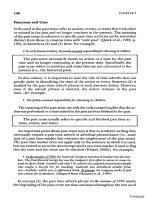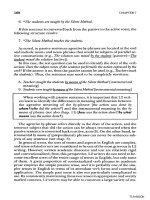Tài liệu Teaching and learning english part 10 docx
Bạn đang xem bản rút gọn của tài liệu. Xem và tải ngay bản đầy đủ của tài liệu tại đây (501.57 KB, 7 trang )
64
24. Linguists use the terms declarative, imperative, interrogative and
S Verb Object
exclamatory for the syntactic forms, and they use statement, command,
Pre
Adverb Conj S Verb Object
question, and exclamation for the function.
Prep
Adverb
(Compound Sentence)
25. Thus, declarative sentences usually have the function of making statement,
S
Freq
Verb Object
interrogative sentences usually ask questions and so on.
S
Freq
Verb
(Compound Sentence)
26. In other words we can say that a declarative sentence makes a statement,
S Verb Dependent Clause
S Verb O
an interrogative sentence asks a question, an imperative sentence issues a
S Verb o S Verb
command or request, and an exclamatory sentence expresses strong
O Conj S Verb O
feeling.
(Complex Compound Sentence)
27. Sometimes a sentence of a given kind has a different function
Adv of Freq S Verb Object
from the usual one.
Prep
(Adverb)
(Simple Sentence)
28. We may also divide the sentences in to simple sentence,
S
Modal
Verb O
Prep
Adverb
compound sentence, complex sentence, and compound complex
sentence.
(Simple Sentence)
29.
A simple sentence consists of a single independent clause and
S Verb O Con
65
does not contain a subordinate clause.
Verb O
(Compound Sentence)
30. It may contain compound subjects and predicates to express
S Verb O C
complex ideas while maintaining a single main clause.
DC
Verb
(Ing Clause)
(Complex Sentence)
31. A compound sentence contains two or more coordinate clauses or
S Verb O Con
consist of two or more simple sentences separated by
Verb O
Verb
(DC)
conjunctions.
(Compound Complex Sentence)
32. That
means that there are at least two units of thought within the
S Verb DC
S Verb Complement Adv
sentence, either one of which can stand by itself as its own
DC
Verb O Adv
sentence.
(Complex Sentence)
33. The clauses of a compound sentence
are either separated by a
S Verb
semicolon (relatively rare) or connected by a coordinating
Con Verb
conjunction (which is, more often than not, preceded by a
DC
comma).
(Compound Complex Sentence)
34.
A complex sentence contains at least one main (independent)
S Verb Complement
clause and one subordinate (dependent) clause.
(Simple Sentence)
66
35. A compound-complex sentence contains coordinate and
S Verb O
subordinate clauses or contains two principal clauses and one or
Conj Verb O
more subordinate clauses.
(Compound Sentence)
36. We have discussed The English sentences.
S Verb O
(Simple Sentence)
37. We
may have difficulty in recognizing sentences, but the most
S Verb Comp
Prep
Adv Conj S
important thing is we need to understand different kind of
Verb
S Verb O
sentences without necessarily knowing the appropriate labels for
DC Verb O
Prep
them.
(Complex Compound Sentence)
References
Crown,1996. Exploring Language. New Zealand: Learning Media
Limited on behalf of Ministry of Education, P O Box 3293,
Ramsay, 1986.
http://english. unitecnology.ac.nz/ resources/resources/
exp_lang/sentence.html
67
Radio” The Innovation of Technology in Education
Muhammad Syukrianto
A. Introduction
It has long been recognized that technology is developed and changed very
fast. Era by era, everyday it has advanced. Radio is one of the important
technologies; by radio we can get information easily although it’s not visual. Radio
has advantages such as it is cheap to buy, it can be brought everywhere even it can
be had by poor people because it is the cheapest media of information.
In the globalization era nowadays, there are more new technologies to get
information easily than before, for instance: computer, internet, hp, etc. Although
Radio seems an old fashioned media, remember, we can get many important things
from it. Radio has been used not only as the medium of information and
communication, but also extensively as an educational medium in developing
countries. Published reports confirm that it has supported educational programs in a
wide range of subject areas and in many different countries. Fro example, this year
in our country, Indonesia there’s KGRE (Kangaroo Radio English) the center is in
Bali, it has English programs. Almost all regency has radio station that join in the
KGRE’s program. So it is important and useful for the students, more over student
of English to improve their English.
In this short paper we are going to discuss the history of radio, the uses of
radio, and how the radio is used as a media of education especially in learning
English.
B. History and invention of Radio
Originally, radio technology was called 'wireless telegraphy', which was
shortened to 'wireless'. The prefix radio- in the sense of wireless transmission was
first recorded in the word radioconductor, coined by the French physicist Edouard
Branly in 1897 and based on the verb to radiate. 'Radio' as a noun is said to have
been coined by advertising expert Waldo Warren (White 1944). The word appears
in a 1907 article by Lee de Forest, was adopted by the United States Navy in 1912
and became common by the time of the first commercial broadcasts in the United
States in the 1920s. (The noun 'broadcasting' itself came from an agricultural term,
meaning 'scattering seeds'.) The American term was then adopted by other
languages in Europe and Asia, although Britain retained the term 'wireless' until the
mid-20th century. In Chinese, the term 'wireless' is the basis for the term 'radio
wave' although the term for the device that listens to radio waves is literally 'device
for receiving sounds'.
Picture 1. The Invention of Radio
USPTO Patent Decision: Wireless Telegraphy
68
The identity of the original inventor of radio, at the time called wireless
telegraphy, is contentious. The controversy over who invented the radio, with the
benefit of hindsight, can be broken down as follows:
Guglielmo Marconi was an early radio experimenter and founded the first
commercial organization devoted to the development and use of radio.
Nikola Tesla developed means to reliably produce radio frequencies, publicly
demonstrated the principles of radio, and transmitted long-distance signals. He
holds the US patent for the invention of the radio, as defined as "wireless
transmission of data."
Alexander Stepanovich Popov, in 1894, built his first radio receiver, which
contained a coherer. Further refined as a lightning detector, he presented it to the
Russian Physical and Chemical Society on May 7, 1895.
Reginald Fessenden
[1]
and Lee de Forest invented amplitude-modulated (AM)
radio, so that more than one station can send signals (as opposed to spark-gap
radio, where one transmitter covers the entire bandwidth of the spectrum).
Edwin H. Armstrong invented frequency-modulated (FM) radio, so that an audio
signal can avoid "static," that is, interference from electrical equipment and
atmospherics.
Early radios ran the entire power of the transmitter through a carbon
microphone. While some early radios used some type of amplification through
electric current or battery, until the mid 1920s the most common type of receiver
was the crystal set. In the 1920s, amplifying vacuum tube radio receivers and
transmitters came into use. The following is the picture of radio transmission.
Picture 2. Radio Transmission
C. The Uses of Radio
There are a number of uses of radio:
1. Audio
AM broadcast radio sends music and voice in the Medium Frequency
(MF—0.300 MHz to 3 MHz) radio
spectrum. AM radio uses amplitude modulation
, in which louder sounds at the
microphone causes wider fluctuations in the transmitter power while the
transmitter frequency remains unchanged. Transmissions are affected by static
because lightning and other sources of radio add their radio waves to the ones
from the transmitter.









